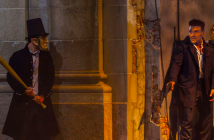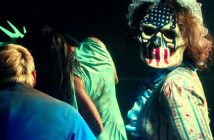
Editor’s Notes: The BFG is currently out in wide theatrical release.
There’s a moment in The BFG, Steven Spielberg’s adaptation of Roald Dahl’s (The Iron Giant, The Witches, Matilda, Charlie & the Chocolate Factory) 1982 children’s classic, where the title character (“Big Friendly Giant”, not “Big F—ing Giant”), avoids detection in 1980s London by pretending to be a tree, a statue, or even a lamppost that perfectly captures the whimsical wonder and awe of Spielberg’s belated return to family-oriented filmmaking that became synonymous with his name three decades ago. It’s the kind of moment other, lesser filmmakers try and fail to duplicate, primarily because it requires not just a light, deft touch mixing live-action and CGI, but it also requires an intuitive understanding of audience psychology few filmmakers actually possess, let alone call upon when needed. It’s also a playful, fantastical moment in a film overflowing with an abundance of such moments, each one carefully crafted to elicit the full array of audience-pleasing chills and thrills, not to mention the balance of poignancy and pathos typical of Spielberg’s finer, more refined work.
The BFG will be recognized if not today, then sometime soon, as a classic-in-the-making for a late-career Spielberg.

Spielberg’s period adaptation depends on the BFG’s (Mark Rylance) near invisibility in the human world. Despite his height (he’s 24-feet tall), he slips in and out of London late at night, sight unseen (pre-Cell Phone Age). Until one night, of course, when Sophie (Ruby Barnhill), an eleven-year-old orphan, spots him outside her window at the “witching hour” (not midnight, but 3:00 a.m. if we’re to believe Sophie). Believing Sophie will tell the world about his existence, the BFG – a name Sophie later gives him – promptly kidnaps Sophie and takes her to his giant-size home in Giant Country. It’s the first sign of many that the malapropism-prone BFG has little, if any, understanding of the ways of humanity, culture, and society. He firmly believes a child can convince adults of a giant’s existence without additional proof. Despite his apparent age – millennia, we soon learn – denoted by his graying, thinning hair and long-limbed, awkward gait, he’s practically as naïve and innocent as Sophie. Their mutual naiveté and curiosity, qualities almost always favored by Dahl in his characters, leads them to eventually shrug off their differences and embrace their commonalities: They’re both outsiders; Sophie because she’s an orphan and the BFG because he’s not only the smallest giant in Giant Country, but he’s a vegetarian, subsisting on a diet of slimy, unappetizing vegetables called snozzcumbers.
The live-action/CGI blend doesn’t always work, but those moments are few and far between.
The BFG’s gentle, empathetic nature – setting aside the kidnapping that brings Sophie and the BFG together – stands in marked contrast with his gigantic, bullying brothers. They have fearsome-sounding names like Fleshlumpeater (Jemaine Clement), Bloodbottler (Bill Hader), Bonecruncher (Daniel Bacon), Gizzardgulper (Chris Gibbs), Manhugger (Adam Godley), Childchewer (Jonathan Holmes), Meatdripper (Paul Moniz de Sa), and Maidmasher (Ólafur Ólafsson). Vegetarians they’re not and once Sophie discovers what they eat (humans, with preference for children), she decides they must be stopped, eventually acquiring the aid of the British Queen (Penelope Wilton), to stop the giants. The giants and what to do about them, however, remains a secondary concern to Spielberg and his screenwriter, the Melissa Mathison (E.T. The Extraterrestrial, The Black Stallion). He’s far more interested in Sophie and the BFG’s relationship and an interlude in Dream Country, a place far above the clouds where dreams, good and bad, are born and where the BFG’s motivation for visiting the human world is revealed: He’s a literal dream giver, using a trumpet-like device to give children dreams.
That fanciful sequence alone, with its literal inversion of up and down (Sophie has to dive in a reflecting pool to get to the other side and back again to return), its multi-colored, pixie-like dream orbs, is practically worth the price of admission on its own, but it’s the BFG, closely resembling actor Mark Rylance, with his oversized ears, protuberant nose, and sharp chin, not to mention his utterly delightful, inventive way with the English language (credit to Roald Dahl, of course), combined with near-perfect CGI this side of the uncanny valley, that makes him such a memorable creation. But where the BFG is a live-action/CGI creation, equal weight falls on the young actress, Ruby Barnhill, who plays Sophie. Spielberg’s talent directing children often gets overlooked in the praise, much, if not all of it, deserved, he’s received over the decades. Once again, however, he elicits a note-perfect performance from a young actor or actress. Barnhill balances Sophie’s youthful exuberance and natural curiosity with an undertow of melancholy for Sophie’s reduced place in the human world.
The live-action/CGI blend doesn’t always work, but those moments are few and far between. That has as much to do with the skills and talents, not to mention the budget, afforded to Spielberg’s collaborators on the animation side as it does on the world building Spielberg and his production designer, Rick Carter. Carter’s credits (Star Wars: The Force Awakens, Lincoln, War Horse, Avatar, War of the Worlds) are proof positive of his world building abilities and the faith Spielberg has in those abilities. Everything from the orphanage Sophie calls home to the BFG’s cave home, filled with all manners of shelves, knick-knacks, dream-filled bottles, and a sailing ship that doubles as his bed, are meticulously designed with an emphasis on texture, detail, and a heightened verisimilitude. And that, at least in part, explains why The BFG will be recognized if not today, then sometime soon, as a classic-in-the-making for a late-career Spielberg.
Carefully crafted to elicit the full array of audience-pleasing chills and thrills, not to mention the balance of poignancy and pathos typical of Spielberg's finer, more refined work.



